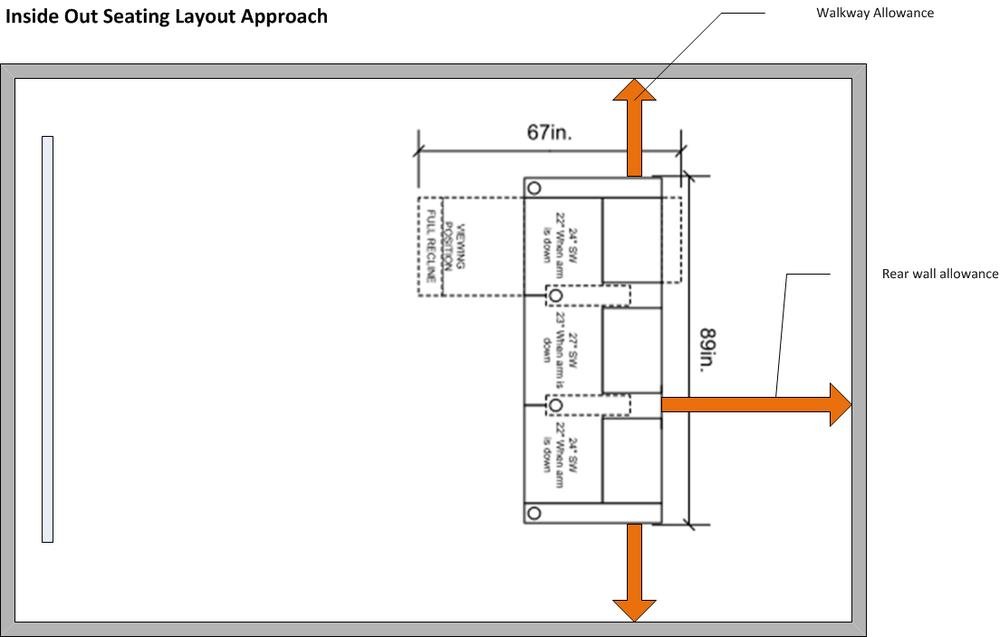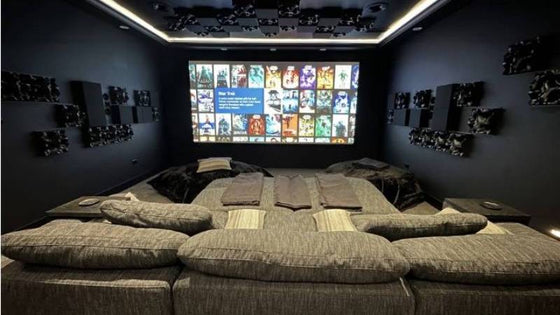Creating a system you love shouldn't be difficult. The Acoustic Frontiers blog is here to help.

The first task that should be done in any home theater design is choosing the number and type of seats. That’s probably surprising to most enthusiasts as they think that equipment is the first thing that should be selected! In fact seating choices end up dictating a lot of other things including room dimensions, acoustic treatment and subwoofer / speaker type and placement.
There are two ways to go about designing seating: from the “outside in” or from the “inside out”.
Outside In
For rooms with fixed dimensions (such as our demo room which was a remodel of an existing space) the approach to use is “outside in”. This means that you start with the room size and use this to determine the maximum number of seats, their type and arrangement into rows.
Inside Out
For rooms where there is flexibility in dimensions, such as a new home or addition, then the approach to use is “inside out”. Choose the number of seats you want and their type, arrange them into rows, and from there specify the room dimensions.

When determining how many seats are required in your theater it is good to think about the “normal” way the theater will be used. A lot of people try to design their theaters for the extreme use cases such as the SuperBowl or once-a-year kid’s party. Most of the time the theater is only going to be used by you and your close family. In addition it is often true that you, the enthusiast reading this article, are the only person in that group who really appreciates great sound. If that is the case then design decisions can be made that will reduce overall project cost.
As an example consider if you went into the design process saying you wanted 12 seats. This number was arrived at by thinking about the maximum number of people who might be in the theater at any one time – the extreme use case. In reality you only have four in your family and 95% of the time it is just the family in there. A better approach, therefore, than trying to design for 12 good seats, would be to design for 4 good seats. Maybe you end up with 8 recliners and a bar area or maybe just one row of 4 recliners and some large bean bags or a couple of couches for the children’s parties. Consider your options and design wisely!
There are a number of performance related design principles that must to considered when laying out home theater seating:
Most of these requirements are simple enough that a DIY’er with a CAD drawing package and some time can can design for them. Others such as ensuring consistent seat-to-seat bass response require in depth knowledge of acoustics and some specialized modeling programs.

Having read and understood these requirements you will be ahead of the majority of DIY’ers whose finished home theaters’ poor seating arrangement and sub-par sound quality bear testament to the mistakes made during the layout process!
In addition to performance relatd considerations there are also practical considerations to ensure the space is usable:
There are many types of seats that can usefully be deployed in a home theater. The most obvious, and the one that takes the most space, is the recliner. Other types are stadium seats, like those found in a commercial cinema, bar seats and couches. Careful choice of seating type, number and placement can be used to ensure that the home theater meets the requirements outlined above.

Home theater recliners take up a lot of space both width and lengthways. Our favorite recliner manufacturer is Fortress who make supremely comfortable and supportive seats in California. Recliners are typically made of leather and come with motorized recline features.
Theater recliners vary in size from manufacturer to manufacturer. As a guideline, however, we can use the following dimensions: 34″ wide including side arms, 38″ deep in their upright position and 67″ deep in their full recline position. Consider therefore that a row of four theater recliners with common arms would be 123″ across (over 10ft). Allowing a 30″ of walkway on either side of the seats gets you to 183″ (or 15.25ft) for minimum room width. Length wise we need to make allowance for walkway in between rows when seats are fully reclined. If we allow 18″ between rows then front to back two rows of seats occupies 152″ (12.7ft).
Because of their size sometimes a room is simply not large enough to fit the number of seats required and in this case other solutions may be more appropriate.
Stadium seats are the type found in commercial cinemas. These seats take up less space than a traditional recliner. Some seats have ‘rocker’ functionality which is a partial recline. As a guideline a stadium seat dimensions can be considered as 26″ wide and 31″ deep. The main advantage of stadium seating over recliners is therefore in seating density – more rows can be fit in less space. Two rows of stadium style seats would fit into a depth of 80″ (6.7ft), which is almost half the depth of two rows of recliners!
Bar seating is typically implemented in a home theater exactly as you might find it in a bar setting. There is a shallow depth bar behind the last row of recliners with a number of high bar stools with footrests used to provide seating. It provides a relatively low cost, space efficient way of fitting a large number of people in your theater for the few times a year when you are having a party or other event.

Couches are great ways to make a home theater more informal than it is with the rows of classical recliners. They are also a good space saver, primarily because of the number of people that can be fit across a couch. Most couches do not have recliner functions so they also take up less depth. Some manufacturers like Fortress make fixed, non-recline-able versions of their home theater seats which can be mixed in with recliners without creating a visually jarring effect.
Want to learn more about the basics of creating your own home theater? Check out the Ultimate Guide to Setting Up a Home Movie Theater from Porch.
If you’re ready for more technical education, check out some of our other home theater design articles.
Learn how early home theater design, layout, and acoustic treatment improve performance in new home construction.
This media room was intentionally designed to feel like part of the home—not a separate, tech-heavy space. Through careful acoustic planning, equipment integration, and final calibration, we achieved a room that is both beautiful to live in and immersive to experience.
"No other subwoofer system I’ve owned even comes close to what this room delivers. Reaching out to Acoustic Frontiers was one of the best decisions I’ve made—I highly recommend working with them if you want to get the most out of your theater."

Nyal Mellor, Founder, Acoustic Frontiers



Nyal Mellor
Author